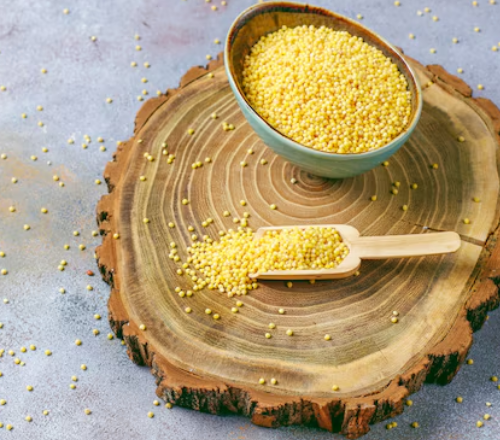Proso Millet: Types, Benefits, and How to Include It in Your Diet
Proso millet is a small-seeded grain that has been grown for thousands of years. Today, this ancient grain is becoming more popular because of its many health benefits and the different ways it can be used in cooking. If you’re looking to add more nutritious foods to your meals, proso millet is an excellent choice.
What Is Proso Millet?
Proso millet, also called common millet or broomcorn millet, is one of the oldest cultivated grains in the world. It grows quickly (ready to harvest in just 60-90 days) and needs very little water compared to other grains. This makes it an environmentally friendly crop that can grow in many different climates.
The tiny, round seeds come in various colors including yellow, white, red, and dark brown. Farmers remove the hard outer hull after harvesting to make the grain ready for cooking. Proso millet has a mild, slightly sweet, and nutty flavor that works well with many different dishes.
Types of Proso Millet
There are several varieties of proso millet grown around the world:
- White Proso: This is the most common type with a pale, yellowish color and mild flavor.
- Red Proso: Has a slightly darker color and sometimes a stronger taste.
- Black Proso: Darker in color with a distinctive appearance.
While proso millet is a specific type, it belongs to a larger family of millets that includes:
Health Benefits of Proso Millet
This tiny grain offers impressive nutritional benefits:
Rich in Nutrients
Proso millet contains important vitamins and minerals including B vitamins, calcium, iron, potassium, zinc, and magnesium. These nutrients support various body functions from energy production to bone health.
High in Protein
With about 12% protein content, proso millet offers more protein than many other grains. This makes it particularly valuable for vegetarian and vegan diets.
Gluten-Free
Proso millet contains no gluten, making it an excellent grain option for people with celiac disease or gluten sensitivity.

Good for Blood Sugar
The complex carbohydrates in proso millet digest slowly, which helps keep blood sugar levels stable. This makes it a smart choice for people managing diabetes or those concerned about blood sugar spikes.

Heart-Healthy
The magnesium and potassium in proso millet support healthy blood pressure. Additionally, it contains beneficial plant compounds that may help reduce inflammation and cholesterol levels.

Supports Digestion
The fiber content in proso millet promotes healthy digestion and may help prevent constipation. Regular consumption can support gut health and help maintain a healthy weight.

How to Cook and Eat Proso Millet
Adding proso millet to your diet is simple. Here’s how to prepare and enjoy it:
Basic Cooking Method
- Rinse 1 cup of proso millet thoroughly under cold water.
- Add to a pot with 2.5 cups of water or broth.
- Bring to a boil, then reduce heat to low.
- Cover and simmer for 15-20 minutes until water is absorbed.
- Remove from heat and let stand, covered, for 5 minutes.
- Fluff with a fork before serving.
Delicious Ways to Include Proso Millet in Your Diet
Breakfast Ideas:
- Cook millet porridge with milk or plant-based alternatives, topped with fresh fruits and honey
- Add cooked millet to smoothie bowls for extra nutrition and texture
- Make millet pancakes by adding millet flour to your batter
Lunch and Dinner Options:
- Use cooked millet as a base for grain bowls with vegetables and protein
- Create pilaf-style dishes by sautéing cooked millet with vegetables and spices
- Add to soups and stews for hearty meals
- Use as a stuffing for vegetables like bell peppers or squash
Snacks and Sides:
- Make millet tabbouleh by mixing cooked, cooled millet with chopped herbs and vegetables
- Form millet patties with beans and spices for a nutritious burger alternative
- Create a simple side dish by tossing cooked millet with olive oil and herbs
Storage Tips
Store uncooked proso millet in an airtight container in a cool, dry place for up to one year. Cooked millet can be refrigerated for 3-4 days or frozen for up to 2 months.
By including proso millet in your regular meals, you’ll not only enjoy its delicate flavor but also benefit from its impressive nutritional profile. This versatile grain offers a sustainable, healthy alternative to more common grains while supporting your overall wellbeing.
If you have no idea to how to cook no problem Millets will be precooked in the form of Noodles, Pasta Health Mix etc.,
Link will be provide below for Millets Noodles, Pasta, Pongal mix and Health mix if any one need please click the link below and place the order.
Nutera is providing us Small Grains Big Nutrition with Millets Noodles, Pasta, Pongal mix, Health mix, ABC blast, Nuts Delights.
Thank you.
Have a Healthy Family.
